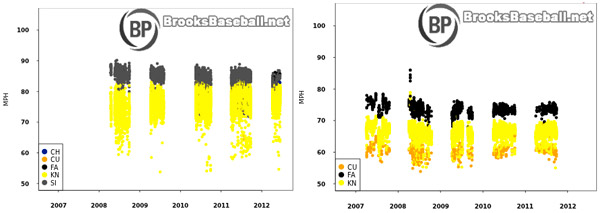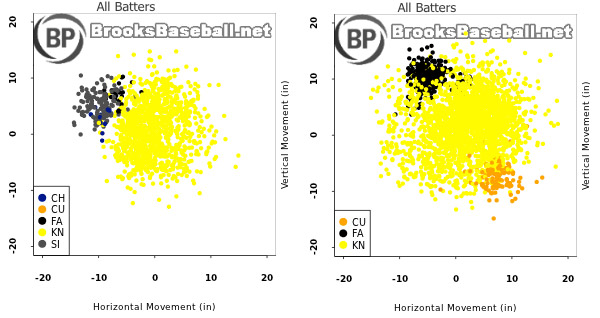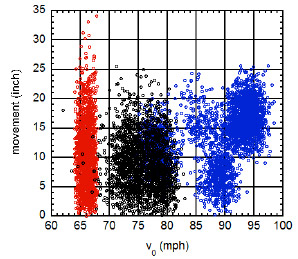Last week I made the case for Chris Sale as the best pitcher in baseball this year. After Mets knuckeballer R.A. Dickey threw his second one-hitter in a row—the first time it's been done in 23 years—it's hard to argue anyone is pitching better than him:
- ERA: tied for first (FWIW, Ryan Dempster is second in baseball)
- Wins: first
- Left on base pct: first (Dempster's third)
- Strikeout percentage: fourth
- K/BB: fifth
- WHIP: first
- Pitch value (measurement of the effectiveness of a single pitch): his knuckler is second to Jake Peavy's fastball.
About the only metric he doesn't fare that well by is walk percentage—he's 23rd among starters—but he's still in the range of pitchers like Jered Weaver, Justin Verlander, and Cole Hamels, and he clearly doesn't walk enough people to hurt his league-leading WHIP. His control is still awfully good for any pitcher, and remarkable for a knuckleballer. Tim Wakefield, the most successful knuckleballer before Dickey, never finished a season with a BB/9 rate of under 2.3; Dickey's currently at 1.9, and walked two in his complete game last night.
The knuckler is devilishly hard to throw, hit, catch, and aim; its lack of spin causes it to essentially move at random. Yet Dickey has excellent control. What's his secret?
First, Dickey throws his knuckleball hard, so hard that he had to go against his training to develop his "angry knuckleball." He also throws it at a wide range of speeds:
Dickey called his pitch an angry knuckleball, not a butterfly, and its speed may separate him from every practitioner who came before. Dickey’s knuckler has averaged 77 m.p.h. this season, according to the Inside Edge Scouting Service, and he has thrown it from 54 m.p.h. to 83 m.p.h.
[snip]
Now, he is throwing 17 percent of his knuckleballs outside the range of 70 m.p.h. to 79 m.p.h., while moving his vertical shoe box up and down, in and out.
Wakefield's knuckleball averaged in the mid-60s. Dickey often throws his knuckleball harder than Wakefield threw his fastball. From Brooksbaseball.net, this is a great graph of Dickey's velocity versus Wakefield's:

And that's a crucial element of his control. His knuckleball doesn't move as much as Wakefield's did. Here's a comparison of the two pitchers' pitches: Dickey on the left in 2012, Wakefield on the right in 2008.

There's a lot of variation in the movement of Dickey's knuckleball, but it averages out to less movement than curves or knucklers. Alan Nathan, a professor emeritus of physics at the University of Illinois, studied Dickey and Wakefield (PDF), and challenges the consensus that "unlike normal pitches, the knuckleball does not follow a smooth trajectory between pitcher and batter but instead can undergo abrupt changes of direction," and argues that it's overrated: "there is little or no evidence in the data for any significant difference in smoothness between knuckleball and normal trajectories…. We conclude that within the precision of the tracking data (less than or equal to 0.5 inch), knuckleball trajectories are as smooth as those of normal pitches."
But within that trajectory, the knuckleball does move randomly. And Nathan found that the speed of Dickey's knuckleball correlates with its accuracy:
Whereas Wakefield throws at a very consistent 66-67 mph, Dickey throw at two speeds: one in the 73-75 mph range, the other in the 75-80 mph range. The plot shows that the movement on the knuckleball is as random in magnitude as it is in direction. Moreover, the maximum movement appears to decrease with increasing speed.
Here's the plot: it compares the movement of Wakefield's knuckleball (red), Dickey's knuckleball (black), and all pitches by Red Sox non-knuckleballer Jon Lester (blue).

Again, Wakefield throws his knuckleball slower, in a very narrow range of velocity; Dickey throws it faster and in a much wider range. Wakefield's knuckleball moves more than Dickey's does, but at a very predictable velocity; Dickey's not only moves less than Wakefield's across an unpredictable range of velocity, it also moves less than Lester's range of pitches.
As Dickey has thrown his knuckleball harder (70.6 mph in 2008 to 77.0 mph in 2012), he's gotten better at throwing it for strikes (43 percent ball rate and 43 percent swing rate to 31 percent ball rate and 53 percent swing rate). And the number of whiffs has almost doubled, from 7.7 percent to 15 percent.
Nathan's conclusion is that "contrary to popular belief, knuckleball trajectories are as smooth as those from normal pitches. However, the data also show that the deflection of a knuckleball from a straight-line trajectory is essentially random in both magnitude and direction." Dickey, in throwing the knuckleball harder across a wider range of velocity, seems to have traded some of the unpredictability of movement for the unpredictability of speed, while improving his control—whether as a result of experience or the physics of dialing up the pitch. The results are amazing, and even amaze Dickey himself. Here, Dickey explains what a good knuckleball looks like:


